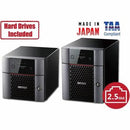Description
The Buffalo TeraStation 3220 is a compact, reliable two-bay desktop NAS designed for small businesses that demand serious data protection and streamlined file management. With 4 TB of total storage across two 2 TB drives included, this NAS delivers ready-to-use, plug-and-play capacity for centralized file sharing, secure backups, and scalable performance. Built to streamline teamwork, protect important documents, and simplify IT administration, the TeraStation 3220 combines user-friendly setup with robust hardware and versatile software to keep your business data safe and accessible. Whether you’re coordinating project files, sharing large media assets, or safeguarding critical customer information, this 2-Bay NAS offers a dependable backbone for small offices and remote teams alike.
- Two-bay desktop NAS with a total of 4 TB of storage already configured (2x 2 TB drives included) for immediate deployment and streamlined setup in small businesses or home offices.
- RAID options for data protection and performance—including RAID 0 for speed and RAID 1 for redundancy—so you can tailor storage resilience to your needs without sacrificing ease of use.
- Centralized file sharing and multi-user access through common network protocols (SMB/CIFS, NFS, FTP), making it ideal for team collaboration, centralized backups, and secure access from multiple devices.
- Comprehensive backup and recovery capabilities designed for business continuity, enabling scheduled backups, versioning, and easy restoration of important documents, photos, and media.
- Compact desktop footprint with simple management tools and remote access options, enabling you to monitor, manage, and retrieve data from anywhere while keeping IT overhead low.
Techncial Details of BUFFALO TeraStation 3220 2-Bay SMB 4TB (2x2TB) Desktop NAS Storage w/ Hard Drives Included
- Device type: Network Attached Storage (NAS) appliance
- Bays: 2
- Total capacity: 4 TB (2 x 2 TB drives included)
- Form factor: Desktop NAS
- Networking: 1 Gigabit Ethernet port for reliable office connectivity
- File sharing protocols: SMB/CIFS, NFS, FTP (multi-client access)
- Cross-platform compatibility: Windows, macOS, and Linux environments supported
- Backup and data protection: RAID 0/1 options for redundancy and performance
- Power and efficiency: Designed for continuous operation in small business settings
how to install [product]
Setting up the Buffalo TeraStation 3220 is straightforward and designed for non-technical users while still offering the flexibility advanced users expect. Follow these steps to have your two-bay NAS up and running in minutes:
1) Unpack and place the NAS on a stable, well-ventilated surface in your office. Ensure there is adequate clearance for airflow and easy access to the Ethernet port.
2) Connect the Ethernet cable from your router or switch to the NAS and plug the power adapter into a grounded outlet. If you are replacing an existing storage solution, consider connecting the NAS to your current network hub to minimize changes to your network settings.
3) Power on the unit and wait for the system to boot. Access the setup interface from a connected computer using the default browser URL provided in the user manual or on the label on the NAS. Most Buffalo NAS devices guide you through a quick setup wizard that detects the included drives and walks you through configuring RAID and network shares.
4) Configure your storage array. Decide whether you want RAID 0 for maximum performance or RAID 1 for redundancy. The setup wizard will guide you through creating shared folders, setting access permissions for different users or groups, and enabling basic security features such as user authentication and network access controls.
5) Create shared folders and map them on client machines. On Windows, use the Network Neighborhood or Map Network Drive feature to connect to the NAS shares. On macOS, use Finder’s Go > Connect to Server and select the SMB path. If needed, enable Time Machine compatibility for macOS backups or configure NFS/FTP access for specialized workflows.
6) Enable essential backup routines. Schedule regular backups of critical business data to the NAS itself, to external USB storage if available, or to remote/cloud destinations supported by your network and transaction security policies. Test restoration of a file to verify your backup plan works as intended.
7) Maintain and monitor. Use the built-in web management interface to check drive health, network status, user activity, and storage usage. Regular firmware updates and security patches from Buffalo help keep your NAS protected against evolving threats and ensure compatibility with new devices on your network.
Frequently asked questions
- Q: What does the package include? A: The Buffalo TeraStation 3220 is a 2-bay NAS with a total 4 TB capacity comprised of two 2 TB drives included. The package typically includes the NAS enclosure, two hard drives, power adapter, Ethernet cable, and quick-start guide. Check your retailer’s listing for exact contents.
- Q: What kind of data protection does it offer? A: It supports RAID configurations (such as RAID 0 for performance and RAID 1 for redundancy) to protect data in case of a drive failure. It also provides centralized backup capabilities, routine scheduling, and secure user access controls to safeguard business files.
- Q: Can this NAS be used with Windows and macOS? A: Yes. It offers SMB/CIFS for Windows networks and can also support macOS via SMB and, where applicable, Time Machine compatibility for backups. NFS and FTP are typically supported for broader compatibility in mixed environments.
- Q: Is remote access possible? A: Many Buffalo NAS models include remote access features and mobile-friendly administration, allowing you to monitor and retrieve files from outside the office. Verify the exact remote access options in the setup interface for your specific firmware version.
- Q: How should I maintain the system? A: Regular firmware updates from Buffalo, routine health checks of the drives, and scheduled backups are recommended. Keep the NAS in a cool, ventilated area and monitor storage usage to plan capacity expansion before you run out of space.
Customer reviews
Showing - Of Reviews


